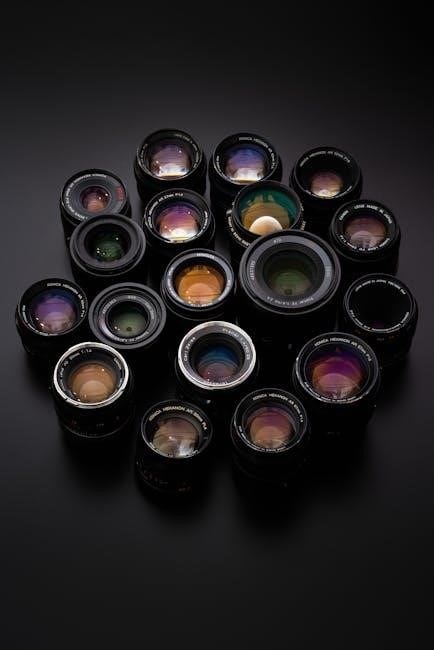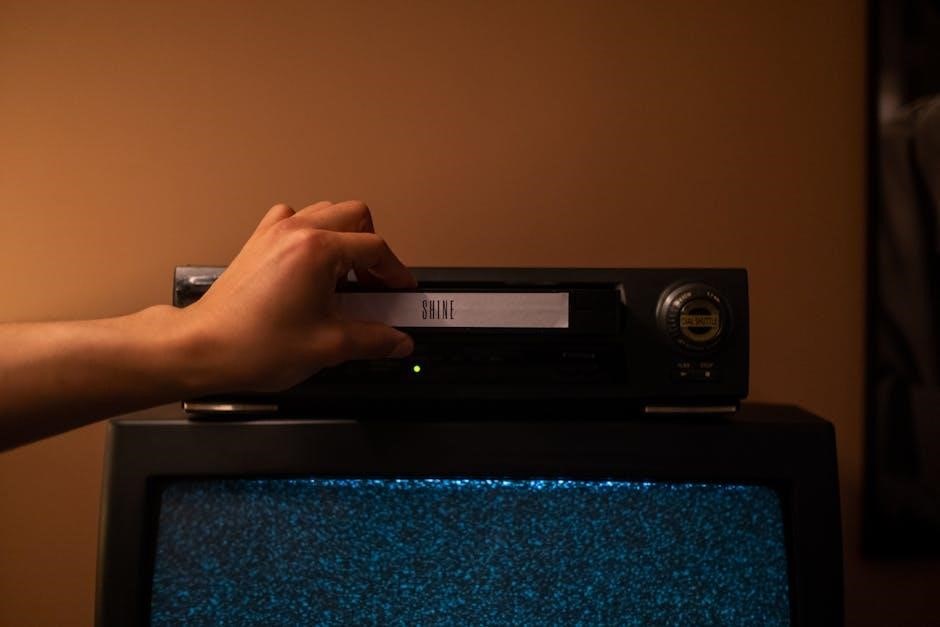A manual scoreboard is a simple‚ reliable tool for displaying scores in sports‚ games‚ and events․ Its simplicity and ease of use make it universally applicable․
1․1 What is a Manual Scoreboard?
A manual scoreboard is a physical display system used to track and show scores in real-time during games‚ sports‚ or events․ It typically consists of numbers‚ markers‚ or indicators that can be adjusted by hand to update scores․ This simple‚ low-tech solution is widely used for its reliability and ease of operation in various settings․
1․2 Importance of Manual Scoreboards in Various Settings
Manual scoreboards are highly valued for their reliability and cost-effectiveness in schools‚ community centers‚ and outdoor events․ They provide a clear‚ easily visible method of tracking scores without requiring electricity‚ making them ideal for low-budget organizations․ Their simplicity ensures minimal maintenance‚ and they can be used in various sports and activities‚ offering a durable solution for diverse settings․
History and Evolution of Manual Scoreboards
Manual scoreboards have a long history‚ evolving from simple chalkboard systems to standardized designs․ They became essential in schools and sports venues due to their reliability and low maintenance‚ remaining a practical choice for many organizations‚ offering a timeless alternative to digital solutions․
2․1 Early Forms of Scorekeeping
The earliest forms of scorekeeping involved simple‚ handmade systems like chalkboards or blackboards․ These basic tools were widely used in schools and sports‚ relying on manual updates․ Over time‚ more organized methods emerged‚ such as flip-score systems‚ which offered greater visibility and ease of use‚ laying the groundwork for modern manual scoreboards․
2․2 Development of Modern Manual Scoreboards
Modern manual scoreboards evolved from basic designs‚ incorporating durable materials like metal and high-quality plastics․ They feature numbered panels‚ easy-to-use mechanisms‚ and customizable options․ Advances in design have improved portability and visibility‚ making them suitable for various indoor and outdoor settings․ Additional features‚ such as timers and indicators‚ enhance functionality‚ ensuring reliability and cost-effectiveness for organizations of all sizes․
Components of a Manual Scoreboard
A manual scoreboard consists of a sturdy frame‚ numbered panels‚ and lettering for displaying scores․ Additional features like timers and indicators enhance functionality‚ ensuring durability and portability․

3․1 Structure and Design
A manual scoreboard typically features a durable frame made of metal or wood‚ with numbered panels that slide or flip to update scores․ Its design emphasizes portability and ease of use‚ often incorporating a user-friendly mechanism for quick score changes․ The structure ensures clear visibility from a distance‚ making it ideal for various settings like sports fields or classrooms․
3․2 Display Mechanism
A manual scoreboard uses a straightforward display mechanism‚ often involving numbered panels or flip charts․ These components allow scores to be updated quickly and easily‚ ensuring clear visibility for spectators․ The simplicity of the mechanism makes it durable and low-maintenance‚ while its large‚ legible design ensures that everyone can see the scores without difficulty․
3․3 Additional Features (e․g․‚ indicators‚ timers)
Beyond basic scoring‚ manual scoreboards often include indicators for timeouts‚ fouls‚ or possession․ Some models feature timers to track game periods or intervals․ These elements enhance functionality‚ allowing seamless management of game flow․ Additional features like LED lights or color-coded sections improve visibility and provide quick updates‚ making the scoreboard versatile for various sports and events․

How to Set Up a Manual Scoreboard
Setting up a manual scoreboard involves assembling the structure‚ attaching digits or sliders‚ and calibrating the display․ Ensure proper alignment and test functionality before use for accuracy․
4․1 Installation and Assembly
Begin by unboxing and organizing all components․ Attach the frame securely to a wall or stand using provided hardware․ Mount digits‚ sliders‚ or indicators according to the scoreboard’s design․ Ensure alignment and stability for accurate functionality․ Follow the manufacturer’s guide for proper assembly․ Double-check connections and test each part to confirm smooth operation before finalizing the setup․
4․2 Calibration and Testing
Calibrate the scoreboard by ensuring all digits‚ sliders‚ or indicators move smoothly and accurately reflect scores․ Test each component to confirm proper function․ Adjust mechanisms as needed for precise alignment․ Verify that the scoreboard is level and secure․ Conduct a final test by simulating real-world scoring scenarios to ensure reliability and consistency․ Refer to the manufacturer’s guidelines for precise calibration steps․

Maintenance and Repair of Manual Scoreboards
Regular maintenance ensures the functionality and longevity of manual scoreboards․ Clean surfaces‚ lubricate moving parts‚ and inspect for wear․ Address repairs promptly to prevent further damage․
5․1 Cleaning and Upkeep
Regular cleaning is essential for maintaining a manual scoreboard’s visibility and functionality․ Use a soft cloth and mild detergent to wipe down surfaces‚ avoiding harsh chemicals․ Lubricate moving parts periodically to ensure smooth operation․ Inspect for wear and tear‚ addressing minor issues promptly to prevent larger problems․ Consistent upkeep extends the lifespan and performance of the scoreboard․
5․2 Common Issues and Solutions
Common issues with manual scoreboards include stuck or misaligned numbers‚ which can be fixed by lubricating hinges or adjusting frames․ Faded digits can be restored with touch-up paint․ Dirt buildup should be cleaned with a soft cloth and mild detergent․ Regular maintenance ensures smooth operation and longevity of the scoreboard‚ keeping it functional and visually clear for all viewers․
Manual vs․ Digital Scoreboards
Manual scoreboards offer simplicity and cost-effectiveness‚ while digital scoreboards provide automation‚ connectivity‚ and advanced features․ Each has unique benefits tailored to different needs and preferences․
6․1 Advantages of Manual Scoreboards
Manual scoreboards are cost-effective‚ easy to use‚ and require no electricity‚ making them ideal for small organizations and temporary events․ They are durable‚ customizable‚ and provide a traditional aesthetic‚ promoting a personal touch in scorekeeping․ Their simplicity ensures reliability and ease of maintenance‚ making them a popular choice for various settings․
6․2 Disadvantages Compared to Digital Scoreboards
Manual scoreboards lack the automation and speed of digital counterparts‚ requiring physical updates that can be time-consuming․ They offer limited functionality‚ unable to display complex data or graphics․ Additionally‚ manual scoreboards rely on human accuracy‚ increasing the risk of errors during fast-paced events‚ making them less efficient for large-scale or high-tech applications compared to digital solutions․
Uses of Manual Scoreboards in Sports
Manual scoreboards are widely used in sports like basketball‚ baseball‚ and volleyball for their portability and ease of use․ They are ideal for smaller leagues‚ training sessions‚ and outdoor events‚ providing a cost-effective solution for keeping track of scores without the need for advanced technology․
7․1 Popular Sports Using Manual Scoreboards
Manual scoreboards are commonly used in sports like baseball‚ basketball‚ and volleyball․ Their simplicity makes them ideal for tracking scores in smaller leagues‚ school matches‚ and community events․ They are also popular in outdoor games due to their portability and ease of use‚ ensuring reliable scorekeeping without the need for advanced technology․
7․2 Customization for Specific Sports
Manual scoreboards can be tailored to suit specific sports‚ enhancing their functionality․ For example‚ baseball scoreboards often include innings trackers‚ while basketball boards may feature shot clocks․ Customization allows for sport-specific indicators‚ ensuring clarity and efficiency in scorekeeping․ This adaptability makes manual scoreboards versatile tools for various athletic events‚ providing precise and relevant information to players and spectators․
Innovations in Manual Scoreboard Technology
Innovations in manual scoreboards include the integration of basic electronics for real-time updates and the use of modern materials for durability and aesthetic appeal․
8․1 Integration with Basic Electronics
Manual scoreboards now incorporate basic electronics‚ enhancing functionality․ LED lights and digital timers improve visibility and accuracy․ Some models offer Bluetooth connectivity for remote updates‚ blending tradition with modern convenience while maintaining reliability․
8․2 Modern Materials and Designs
Modern manual scoreboards feature durable‚ lightweight materials like aluminum and high-quality plastics․ Sleek designs enhance portability and ease of use․ Customizable layouts and interchangeable components allow for tailored solutions․ Advanced finishes improve visibility and aesthetics‚ making them suitable for various settings while maintaining their traditional appeal and functionality․

Cost-Effectiveness of Manual Scoreboards
Manual scoreboards are a budget-friendly option with low upfront costs and minimal maintenance‚ making them a financially sustainable choice for small organizations and events․
9․1 Budget-Friendly Option for Small Organizations
Manual scoreboards are an affordable solution for small organizations‚ offering low initial costs and minimal maintenance․ They require no electricity‚ reducing long-term expenses․ Their durability ensures years of reliable use‚ making them a cost-effective choice for schools‚ community centers‚ and local sports leagues with limited budgets․
9․2 Long-Term Durability and Value
Manual scoreboards are built to last‚ with sturdy materials and minimal moving parts‚ ensuring they withstand years of use․ Their low-maintenance design and lack of electronic components reduce the risk of mechanical failure‚ providing long-term reliability and value for organizations․ This durability makes manual scoreboards a practical‚ cost-efficient investment for sustained use in various settings․
Manual scoreboards remain a timeless‚ practical solution for scorekeeping‚ blending simplicity with reliability․ Their enduring relevance ensures continued use alongside evolving technologies‚ offering a steadfast option for various applications․
10․1 Summary of Key Points
Manual scoreboards are simple‚ reliable tools for displaying scores in sports and events․ They are cost-effective‚ easy to maintain‚ and offer a practical solution for organizations․ Their simplicity ensures they remain relevant‚ even with technological advancements․ They are widely used in various sports‚ customizable‚ and durable‚ making them a valuable investment for schools‚ clubs‚ and small organizations seeking a low-tech yet effective scoring solution․
10․2 Future of Manual Scoreboards
Manual scoreboards will remain relevant due to their simplicity and cost-effectiveness․ They may integrate basic electronics for enhanced functionality while retaining their traditional appeal․ Innovations in materials and design will ensure durability and modern aesthetics․ As digital solutions grow‚ manual scoreboards will find a niche in traditional or low-tech settings‚ offering a reliable‚ customizable option for schools and small organizations․
